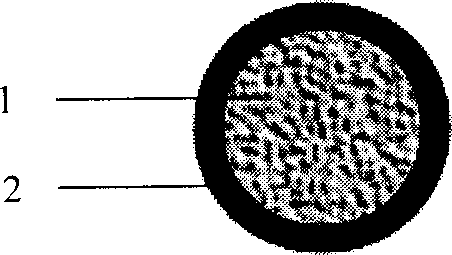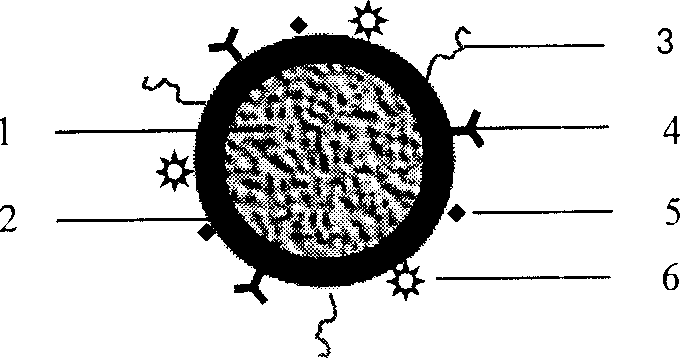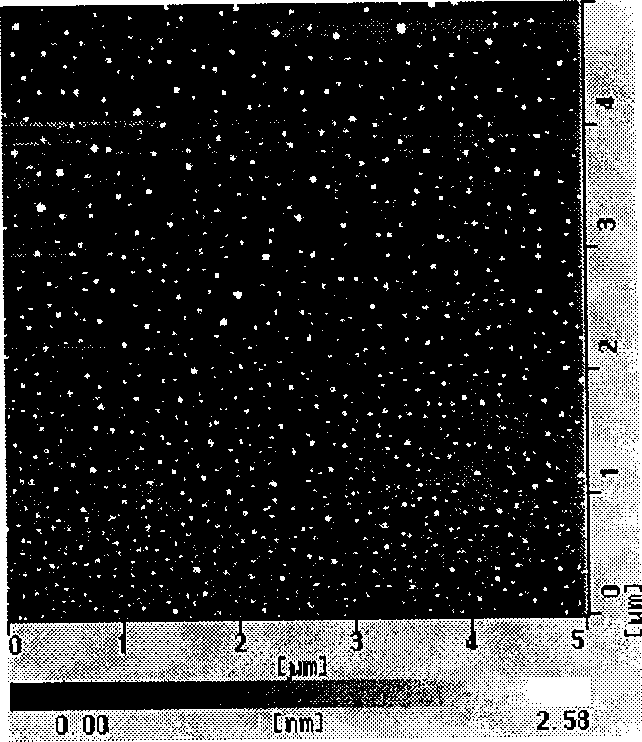Nano granule of polylysine amylum and its preparation method as well as application gene carrier
A poly-lysine and starch nanotechnology, applied in biological nanotechnology and its application fields, can solve the problems of inability to degrade and discharge in time, have immunogenicity, and inorganic nanoparticles cannot be degraded in the body, and achieve DNA loading capacity. Large, low cost, mild effect
- Summary
- Abstract
- Description
- Claims
- Application Information
AI Technical Summary
Problems solved by technology
Method used
Image
Examples
Embodiment 1
[0035] (1): Preparation of anionic starch nanoparticles
[0036] 1. Preparation of water phase: Prepare starch into a 10% aqueous solution, heat and decompose it in boiling water at 100°C until the solution is clear, then place it at room temperature to cool.
[0037] 2. Oil phase preparation: Take 15ml of toluene and 5ml of chloroform, add 2% of the total volume of surfactant SPan80, stir and mix at a speed of 500 rpm.
[0038] 3. Take 1ml of starch hydrolyzate and add it to the high-speed stirring oil phase, and continue stirring for 20 minutes until a tiny emulsion is formed.
[0039] 4. Add the crosslinking agent POCl accounting for about 0.01% of the starch mass 3 , continue to stir and react for about 30 minutes, then wash three times with 95% alcohol, and freeze-dry to obtain anionic starch nanoparticles with a size of 30-50mm and a potential value lower than -5mV in a neutral pH environment. (2): Preparation of polylysine starch nanoparticles
[0040] 1. Weigh 1 mg ...
Embodiment 2
[0045] Transduction and expression of polylysine starch nanoparticles loaded with green fluorescent protein gene (pEGFP) in human tumor cells
[0046] 1. Construction of nano-gene carrier: Take 10 μl of poly-lysine starch nanoparticle aqueous suspension with a concentration of 1 μg / μl, add 3 μg pEGFP plasmid DNA, mix well, and place at room temperature for 30 minutes.
[0047] 2. Dilution of the nanogene carrier: add the above-mentioned DNA / nanoparticle complex into 100 μl of serum-free medium, mix well, and let stand for 30 minutes.
[0048] 3. Co-cultivation and transformation: Add the medium containing the DNA / nanoparticle complex dropwise to the culture dish in which the human breast cancer cells are cultured, co-cultivate for 5-8 hours, and then add complete medium for co-cultivation.
[0049] 4. Detection of transgenes: After 24-48 hours of co-cultivation, observe the fluorescence of the cells under a fluorescence microscope. see Image 6 , fluorescence indicates that ...
Embodiment 3
[0051] Transduction of polylysine starch nanoparticles loaded with green fluorescent protein gene (pEGFP) in rice callus cells.
[0052] 1. Construction of nano-gene carrier: Take 10 μl of polylysine starch nanoparticle aqueous suspension with a concentration of 1 μg / μl, add 3 μg of pEGFP plasmid DNA, mix well, and place at room temperature for 30 minutes to obtain DNA / nanoparticle complexes.
[0053] 2. Establishment of rice suspension cell line: Transplant well-growing rice callus into fresh medium of MS+BA 0.2 mg / l+2,4-D 1 mg / l. One week later, the uppermost callus was selected and transferred to the culture medium, and cultured in the dark for 48 hours on a shaker at 110 rpm.
[0054] 3. Co-cultivation: Add acetosyringone to the above-mentioned culture medium with a final concentration of 100 μM, sonicate for 15 seconds, add DNA / nanoparticles, and co-cultivate on a shaker at 110 rpm.
[0055] 4. Detection of transgene: after 36 hours of co-culture, observe whether there i...
PUM
| Property | Measurement | Unit |
|---|---|---|
| Potential value | aaaaa | aaaaa |
Abstract
Description
Claims
Application Information
 Login to View More
Login to View More - R&D
- Intellectual Property
- Life Sciences
- Materials
- Tech Scout
- Unparalleled Data Quality
- Higher Quality Content
- 60% Fewer Hallucinations
Browse by: Latest US Patents, China's latest patents, Technical Efficacy Thesaurus, Application Domain, Technology Topic, Popular Technical Reports.
© 2025 PatSnap. All rights reserved.Legal|Privacy policy|Modern Slavery Act Transparency Statement|Sitemap|About US| Contact US: help@patsnap.com



